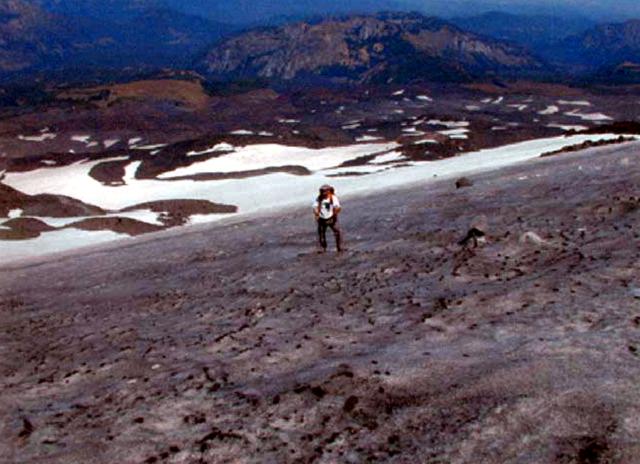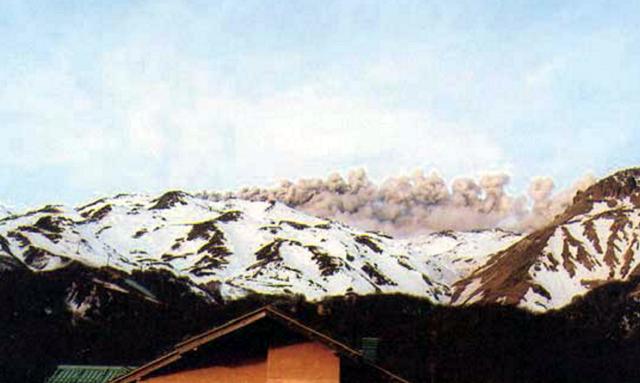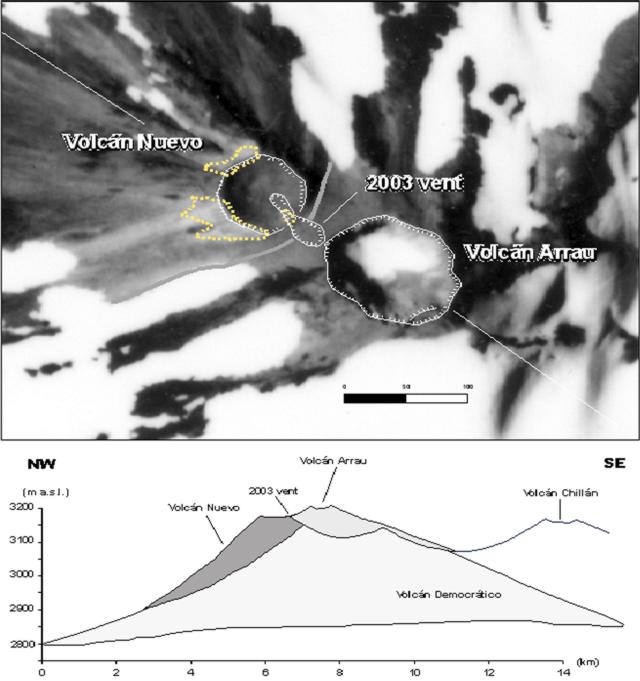Report on Nevados de Chillan (Chile) — March 2004
Bulletin of the Global Volcanism Network, vol. 29, no. 3 (March 2004)
Managing Editor: Richard Wunderman.
Nevados de Chillan (Chile) A small eruption, the first since 1986, during August-September 2003
Please cite this report as:
Global Volcanism Program, 2004. Report on Nevados de Chillan (Chile) (Wunderman, R., ed.). Bulletin of the Global Volcanism Network, 29:3. Smithsonian Institution. https://doi.org/10.5479/si.GVP.BGVN200403-357070
Nevados de Chillan
Chile
36.868°S, 71.378°W; summit elev. 3180 m
All times are local (unless otherwise noted)
Nevados de Chillán was active from 1973 through 1983; after that, phreatomagmatic eruptions were reported to have almost ended. A small (VEI 1) eruption, the first since 1986, was noted by local inhabitants and tourists in August-September 2003. Low magnitude explosive events occurred over the week ending 27 August 2003, sending brown-gray to white gas-and-ash columns up to heights of 500 m for periods of up to 25 minutes. Resulting deposits were ~ 1 cm deep over a sharply defined 2.2 km wide zone to the SSE. Prevailing winds were strong around the time of the eruption (figure 2). Explosions then became more sporadic, occurring at 2-3 day intervals, until ceasing in mid-September.
An inspection of the eruption site on 22 January 2004 by Servicio Nacional de Geoligica y Mineria scientists revealed a new compound, fissure-like, double crater in the saddle between the cones Nuevo (which erupted during 1906-1945) and Arrau (which erupted during 1973-1986) (figure 3). This new ~ 64 m long double crater consisted of a NW situated, 25 x 14 m crater and a SE situated, 39 x 28 m crater. These craters lie to the NW of Arrau cone and become surrounded by an area of intense fumaroles towards Nuevo cone. The fumaroles are water-vapor rich but give off a weak sulfur odor. On Nuevo's E side they had temperatures of up to 88°C (table 1). While no previous measurements were available, this area showed more intense fumarolic activity than seen during a January 1994 visit and 1998 air photographs. During the recent visit the local heat-flow appeared concentrated adjacent to Nuevo cone, rather than Arrau cone. This, and the fissure-like form of the 2003 crater, were taken as evidence for possible future eruptions closer to Nuevo cone.
Table 1. Site names, locations (as UTM coordinates), and fumarole temperatures describing conditions at Nevados de Chillán on 22 January 2004. The fumaroles were located near the 2003 vent. Courtesy of J.A. Naranjo and L.E. Lara, SERNAGEOMIN.
| Site | UTM N | UTM W | Temperature (°C ± 0.5) |
| SW Nuevo flank | 288.086 | 5916.963 | 87.2 |
| E Nuevo rim | 288.138 | 5917.522 | 87.9 |
| Between craters | 288.263 | 5917.547 | 57.4 |
In addition to dispersal and deposition of loose ash, the January inspection noted agglutinates forming a series of 2 m long ridges or 'dunes' (figure 4). The agglutinates consisted of wet black clusters of ash spheres with 0.5- to 1-cm diameters. A large number of dead insects in the agglutinated ash suggested extreme conditions such as the presence of toxic gasses. When dry, the ash was dark gray with a lithic-rich polymodal composition. Particle sizes ranged from dust to 4-5 mm, of which 5-10% was coarse-grained, lithic-rich lapilli composed of black, gray, and red aphyric andesites and ~ 60% was fine- to medium-grained lapilli composed of lithic clasts, quartz, and plagioclase crystals. Below the 1 mm size range, black glassy shards appeared with cleaved vesicle surfaces and blocky or plate-like shapes. The remnant fraction was light-gray fine ash.
 |
Figure 4. January 2004 view of dried ash deposits from Nevados de Chillán's 2003 eruption. The darker deposits lay atop remnant snow pack. Courtesy Servicio Nacional de Geoligica y Mineria. |
Reference. Naranjo, J.A., and Lara, L.E., 2004, August-September 2003 small vulcanian eruption at the Nevados de Chillán Volcanic Complex (36°50'S), Southern Andes (Chile). Revista Geológica de Chile, Vol. 31, No. 2, p. 359-366. DOI: 10.4067/S0716-02082004000200011.
Geological Summary. The compound volcano of Nevados de Chillán is one of the most active of the Central Andes. Three late-Pleistocene to Holocene stratovolcanoes were constructed along a NNW-SSE line within three nested Pleistocene calderas, which produced ignimbrite sheets extending more than 100 km into the Central Depression of Chile. The dominantly andesitic Cerro Blanco (Volcán Nevado) stratovolcano is located at the NW end of the massif. Volcán Viejo (Volcán Chillán), which was the main active vent during the 17th-19th centuries, occupies the SE end. The Volcán Nuevo lava-dome complex formed during 1906-1945 on the NW flank of Viejo. The Volcán Arrau dome complex was then constructed on the SE side of Volcán Nuevo between 1973 and 1986, and eventually exceeded its height. Smaller domes or cones are present in the 5-km valley between the two major edifices.
Information Contacts: Jose A. Naranjo and Luis E. Lara, Servicio Nacional de Geoligica y Mineria (SERNAGEOMIN), Av. Santa Maria 0104, Santiago, Chile.



